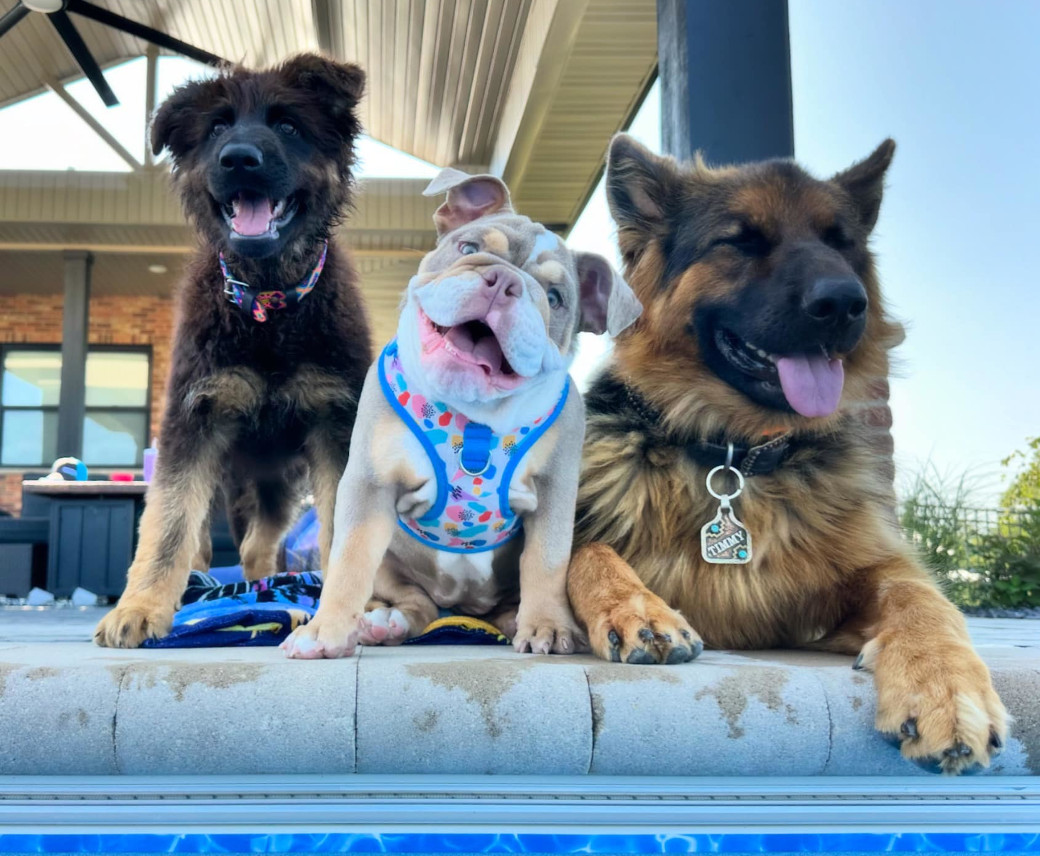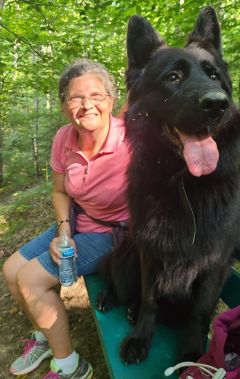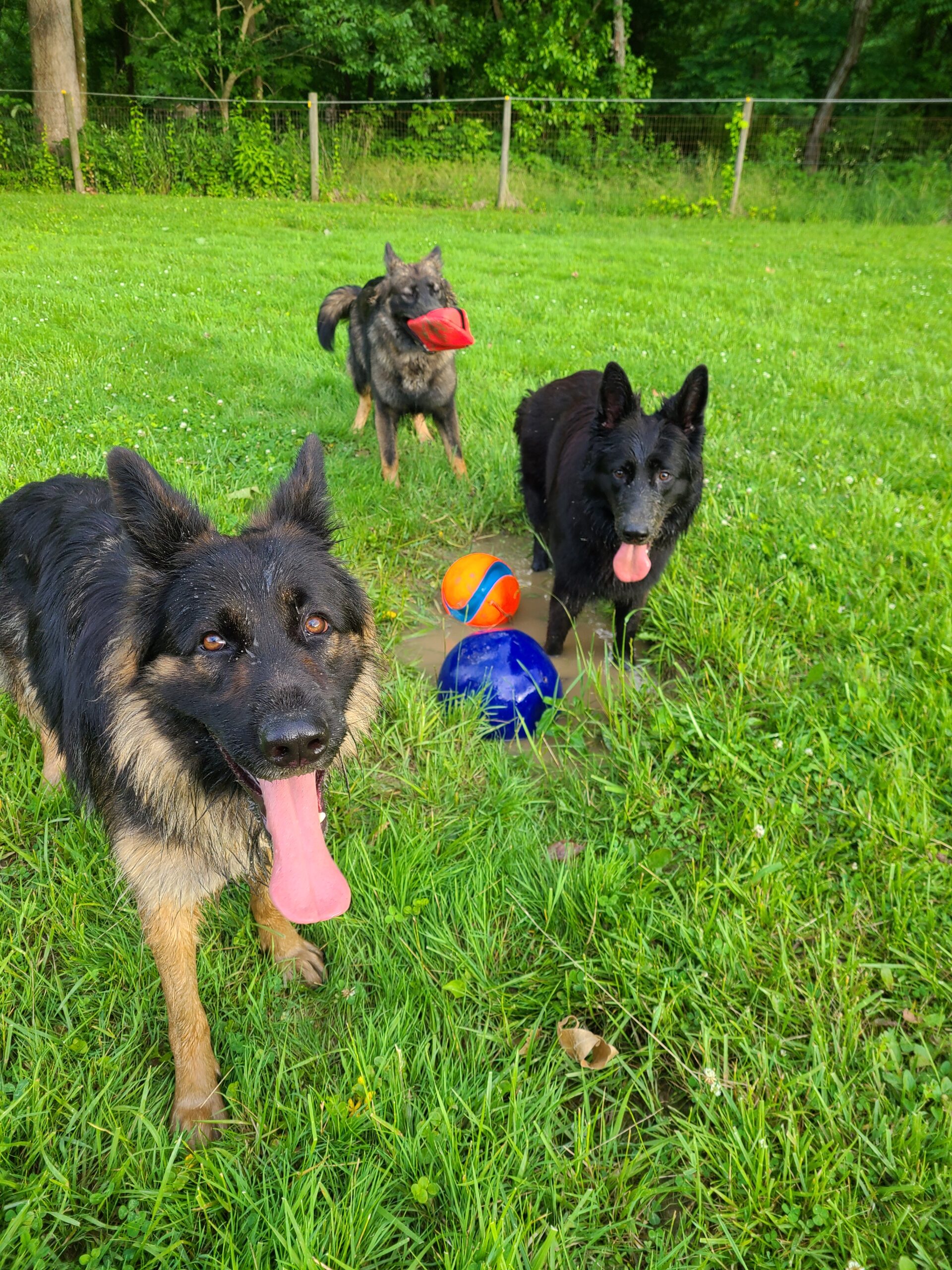Paddy has retired from Stony Lonesome GSD, and has found his new family! Details to follow.
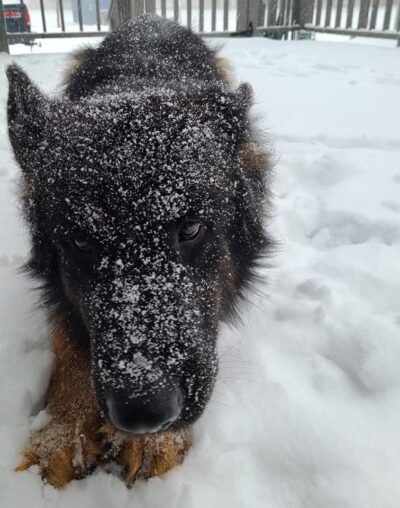
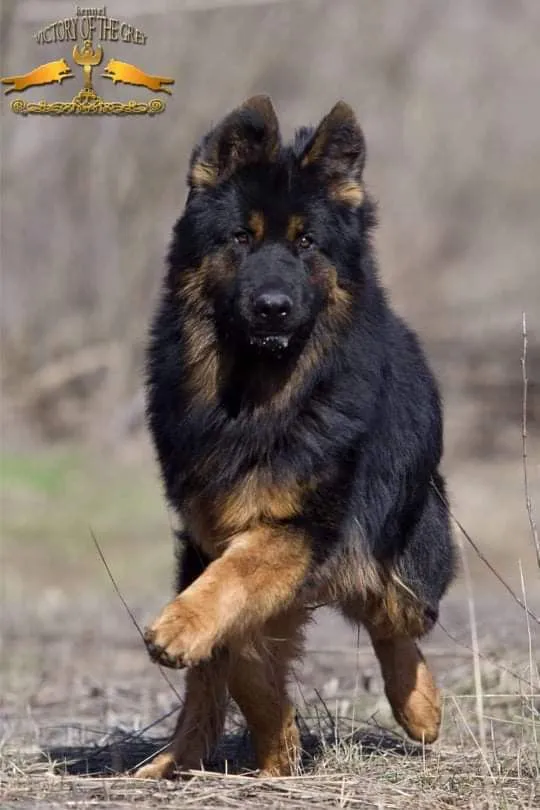
Why do so few puppies grow into truly outstanding dogs
when almost all are so fun and loving when you visit different litters to select your new pal? Well, first, puppies are individuals. Second, at eight weeks they’re only in puppy mode. Adolescent & adult behaviors haven’t kicked in yet. Third, owners matter. Those are all obvious.
But fourth, the first eight weeks matter in ways you can’t see till much later. The lifetime consequences of how the puppy is started can’t be overstated.
Puppies rapidly go through a number of preparatory and developmental stages as their brains develop and various systems come online in their first weeks. While some of this is immediately visible, some is machinery that won’t be used till adolescence or adulthood.
Puppihood is a short phase. A new dog will appear between six and nine months when adolescence begins, and again between two and three years as adulthood begins and the final dog emerges. Most of this later development builds on foundations laid in the first couple months of puppihood.
The owner’s input is also huge, but from conception through the early formative periods, the deck is heavily stacked either in favor of or against your puppy growing into a smart, happy, confident, trustworthy, outgoing, people-loving, playful and well-mannered dog.
If you get a cute, sweet puppy and it can’t be potty trained or goes bonkers when you leave the house, or barks crazily at most dogs or people or is afraid of its shadow or is really slow on the uptake, it probably isn’t all your fault. Especially if you’ve done your part in raising it. (Continued below . . .)
Catch up on what’s new with our puppies and their forever families and the SL crew at At work & play! Below is a sample:
Enriched pups? What’s the difference?
Stony Lonesome GSD (SL) works to produce top-tier pet GSDs using love, science, common sense and lots of elbow-grease. We start by keeping all our dogs as loved and loving house pets, in an enriched and fulfilling environment.
Next, we breed and start a couple of litters per year, using our protocol drawn from different experts, our network and from many years of experience. We put over 200 hours of attention and skill into enriching each litter and its individual puppies. That’s in addition to all the hours of caring for the basic needs of the litter, the mother and our other adults. Whew!
Of course we start all of our litters in our kitchen and family room, so that when an SL pup goes home, all it’s ever known is being at the center of an active, loving home, just like yours.
For the litter and for each puppy, every week from conception through eight weeks of age is carefully scripted to take full advantage of the phases that a pup goes through in its rapid development.
For example, dendrites are added or pruned, starting at three days of age, by seven weeks loud sounds will either be a source of fear or are conditioned to be a curiosity to be investigated, and by eight weeks the foundations will have been laid for a soft mouth to develop or not.
The litter’s environment is also crafted to take full advantage of opportunities to enrich, and to develop mentally and physically. Even the litter’s nutrition serves long term goals. (Continued below . . .)

Without a proper environment that is kept painstakingly clean
a puppy’s natural instinct for cleanliness may be defeated. Puppies like this may be very difficult or impossible to completely housebreak, though that’s not usually apparent when meeting an 8 week old puppy. Is there any way to tell if either of the puppies in the random pictures above was started to make housebreaking as easy as possible?
What are Stony Lonesome’s main goals for producing top-tier pet GSDs?
1: Excellent bite control – appropriate response to frustration and to events that might scare unenriched pups. The GSD bite is hundreds of pounds psi and lack of bite control is the #1 reason GSDs are put down, no matter how wonderful they are in other ways.
2: GSDs that are started toward being exceptionally loving toward their people and well mannered toward all people and dogs.
3: Great health.
4: We love GSDs that look and act like the classic GSD. From the AKC Breed Standard:
- The first impression of a good German Shepherd Dog is that of a strong, agile, well muscled animal, alert and full of life.
- The breed has a distinct personality marked by direct and fearless, but not hostile, expression, self-confidence and a certain aloofness that does not lend itself to immediate and indiscriminate friendships. The dog must be approachable, quietly standing its ground and showing confidence and willingness to meet overtures without itself making them.
- It is poised, but when the occasion demands, eager and alert; both fit and willing to serve in its capacity as companion, watchdog, blind leader, herding dog, or guardian, whichever the circumstances may demand. The dog must not be timid, shrinking behind its master or handler; it should not be nervous, looking about or upward with anxious expression or showing nervous reactions, such as tucking of tail, to strange sounds or sights.
- Lack of confidence under any surroundings is not typical of good character. Any of the above deficiencies in character which indicate shyness must be penalized as very serious faults and any dog exhibiting pronounced indications of these must be excused from the ring. It must be possible for the judge to observe the teeth and to determine that both testicles are descended.
- Any dog that attempts to bite the judge must be disqualified. The ideal dog is a working animal with an incorruptible character combined with body and gait suitable for the arduous work that constitutes its primary purpose.
5: Intelligence, eagerness to learn and meet people and dogs, and to seek out new experiences.
6: Finally, the best possible customers for the puppies we’ve put so much of ourselves into.
Puppies are individuals, so we can’t make absolute promises, but we work tirelessly to give all our pups a great head start in almost all of these directions. An example of a difficulty: consistent aloofness has proven to be a little iffy. (Continued below . . .)

The most serious aspect of a pet with a powerful bite, especially a GSD, is good bite control.
Good bite control can be started by the breeder and should be continued by the owner using specific techniques. Conditioning for superior stress handling is a major part of bite control and of starting a puppy properly. These traits are not normally very visible when customers are looking at eight week old puppies, but become much more apparent as the puppy enters adolescence and adulthood. Is there any way to tell if either of the puppies in the random pictures above was started with a protocol optimized for stress handling and bite control?
Is every home a good fit for a Stony Lonesome GSD?
First, about dogs in general: they’re expensive, a lot of work, they might chew or mess on a prized possession, and they might decide to dig up that mole run that goes across your entire back yard. And the bigger and more energetic, the more trouble they can cause. Training takes time and will never prevent all problems with every dog, and your dog will be with you for many years. That’s many thousands of dollars and many, many hours of your time.
Well, in spite of all that, for those who can provide a top-tier pet home, dogs add love, joy, relationship and dimension to your life. In a century filled with strife, complexity, division and chaos they call us to be kinder and to exercise more and to be in the here-and-now more and experience playful and joyful physical reality. Dogs really crave our company. Plus they’re really loyal and they see us as trustworthy leaders and the most important person in the world, which is good for our self esteem!
So no, not every home is not a good fit for a dog, for a GSD of any age, or for an enriched, Stony Lonesome GSD, which is conditioned to hunger for an active life.
But there is a significant investment of time, energy and money, and your home and yard probably won’t be as nice as they were B.G. (Before GSD). This is where the best owners shine. A top-tier owner understands that:
1: committing to the GSD breed isn’t for everyone. If you want a milder dog, consider a Corgi or a Pug, etc. If you want a dog that loves everyone consider a Golden. There are scores of absolutely wonderful breeds that aren’t bred as megawatt working dogs. GSDs are expensive to maintain because of their size and energy, and require life-changing amounts of daily interaction and physical and mental exercise. Expect this to go on for 10 or more years. But in exchange, they give life-changing amounts of love and enjoyment. It feels good when you can keep up with a GSD and when you can grow into a top-tier dog owner. There’s no question – the best dogs bring out the best in most people!
2: the happiest dogs are able to navigate and enjoy both the human and canine worlds. Dogs may do what you want a lot of the time, but they aren’t people and aren’t happy when confused with people. They’re dogs.
3: a top-tier pet only happens for an owner who is constantly applying what they’re learning from their network, from training classes, from books, etc. For example, what do all those different types of barks mean? Our dogs are trying to tell us things and we don’t usually understand. How frustrating for dogs! Wouldn’t it be nice to better understand?
These are the forever homes we’re looking for.
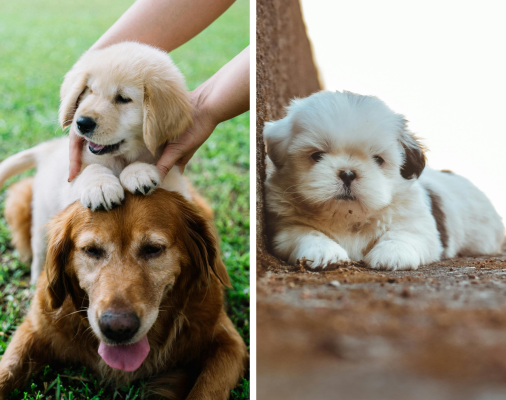
Puppies that are appropriately challenged and stimulated throughout their first eight weeks
tend to be much more confident. This is important to counter a canine’s natural tendency to become increasingly timid and fearful as they age, starting in adolescence, between six and nine months, but continuing up to the start of adult hood, as late as year three. Quality starting of puppies is usually but not always apparent in the hour or so that people get to see their puppy before taking it home. Is there any way to tell if either of the puppies in the random pictures above was started with a protocol optimized for confidence or stress handling?
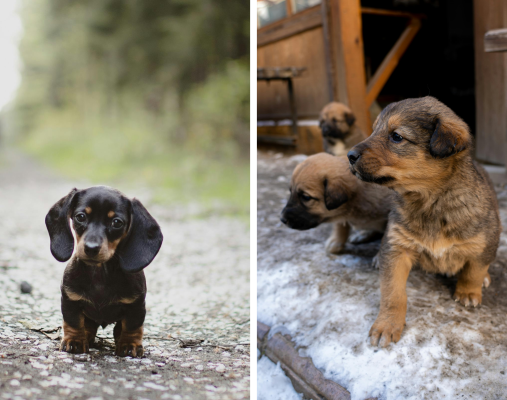
Puppies that are snuggled for at least three minutes a day starting at day three
are conditioned to get increased pleasure and satisfaction from humans, especially their owners. This pre-conditioning matters in adolescence and adulthood as normal canine behavior develops, which does not naturally include unbounded affection toward people. Is there any way to tell if the puppies in the random pictures above were started with a protocol optimized for attachment to their owners?
Please join us in our mission – to develop top-tier GSD homes across the nation where people and their GSDs love, develop, learn from and enjoy each other.
A top-tier GSD home will care enough about their dog to work at understand the dog’s communications, needs and desires, and to provide structure in which the dog will develop into a confident, healthy, well-rounded and pleasant animal. We are excited to work with people who are a good match for the GSD breed and for our kennel, and want to help in matching with the right pup, and by supplying any information that can aid development into a top-tier GSD home!
Of course poorly started dogs can turn out wonderfully, and we can’t absolutely guarantee that Stony Lonesome GSDs will always be the best in every important area since they are individuals, but we work to give each pup the best head start possible in many, many significant areas. And the feedback from our customers is exciting!
Browse this website or the StonyLonesomeGSD Facebook group if you’d like to learn more. We’re small, but we’ve begun the most amazing network of friends and would love to welcome you into our vibrant community!
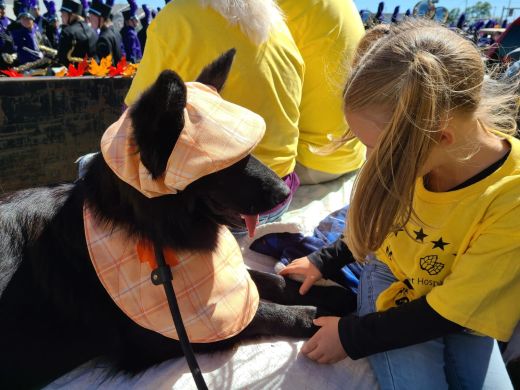
Mademoiselle Genesee, taking in the Seymour Oktoberfest parade from our vet’s float. She made friends and accepted her costume with patience and grace and acknowledged her fans. “Je vous adore tous!”

